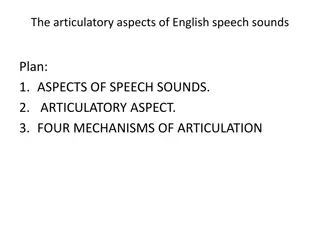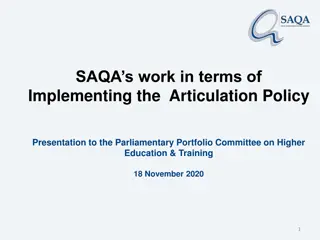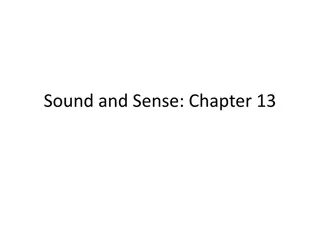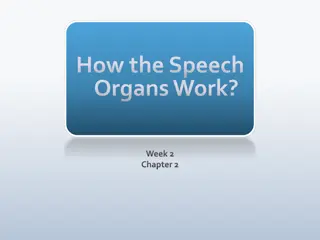The Sounds of Language: Phonetics, Voiced Sounds, and Articulation
Phonetics is the study of speech sounds, divided into articulatory, acoustic, and auditory branches. Voiced sounds are created by vocal fold vibrations, while place of articulation denotes where sounds are produced. Explore bilabials, labiodentals, dentals, alveolars, and palatals in the intricate system of speech production.
Download Presentation

Please find below an Image/Link to download the presentation.
The content on the website is provided AS IS for your information and personal use only. It may not be sold, licensed, or shared on other websites without obtaining consent from the author.If you encounter any issues during the download, it is possible that the publisher has removed the file from their server.
You are allowed to download the files provided on this website for personal or commercial use, subject to the condition that they are used lawfully. All files are the property of their respective owners.
The content on the website is provided AS IS for your information and personal use only. It may not be sold, licensed, or shared on other websites without obtaining consent from the author.
E N D
Presentation Transcript
StudyMafia.Org Tracheostomy Submitted To: Studymafia.org Submitted By: Studymafia.org
Table Contents Definition Introduction Why it's done Emergency Care Risk-Factors of Tracheostomy Preparation of Tracheostomy Expectations from Tracheostomy Complications of Tracheostomy Treatment of Tracheostomy Conclusion 2
Definition Tracheostomy (tray-key-OS-tuh-me) is a hole that surgeons make through the front of the neck and into the windpipe (trachea). 3
Introduction A tracheostomy provides an air passage to help you breathe when the usual route for breathing is somehow blocked or reduced. A tracheostomy is often needed when health problems require long-term use of a machine (ventilator) to help you breathe. When a tracheostomy is no longer needed, it's allowed to heal shut or is surgically closed. For some people, a tracheostomy is permanent. 4
Why it's done Medical conditions that make it necessary to use a breathing machine (ventilator) for an extended period, usually more than one or two weeks Medical conditions that block or narrow your airway, such as vocal cord paralysis or throat cancer Preparation for major head or neck surgery to assist breathing during recovery 5
Why it's done Paralysis, neurological problems or other conditions that make it difficult to cough up secretions from your throat and require direct suctioning of the windpipe (trachea) to clear your airway Severe trauma to the head or neck that obstructs breathing Other emergency situations when breathing is obstructed and emergency personnel can't put a breathing tube through your mouth and into your trachea 6
Emergency care Most tracheotomies are performed in a hospital setting. However, in the case of an emergency, it may be necessary to create a hole in a person's throat when outside of a hospital, such as at the scene of an accident. Emergency tracheotomies are difficult to perform and have an increased risk of complications. 7
Emergency care A related and somewhat less risky procedure used in emergency care is a cricothyrotomy (kry-koe-thie-ROT- uh-me). This procedure creates a hole directly into the voice box (larynx) at a site immediately below the Adam's apple (thyroid cartilage). Once a person is transferred to a hospital and stabilized, a cricothyrotomy is replaced by a tracheostomy if there's a need for long-term breathing assistance. 8
Risk factors of Tracheostomy Immediate complications include: Bleeding Damage to the trachea, thyroid gland or nerves in the neck Air trapped in tissue under the skin of the neck (subcutaneous emphysema), which can cause breathing problems and damage to the trachea or food pipe (esophagus) 9
Risk factors of Tracheostomy Misplacement or displacement of the tracheostomy tube Buildup of air between the chest wall and lungs (pneumothorax), which causes pain, breathing problems or lung collapse A collection of blood (hematoma), which may form in the neck and compress the trachea, causing breathing problems 10
Risk factors of Tracheostomy Long-term complications are more likely the longer a tracheostomy is in place. These problems include: Obstruction of the tracheostomy tube Displacement of the tracheostomy tube from the trachea Damage, scarring or narrowing of the trachea Infection around the tracheostomy or infection in the trachea and bronchial tubes (tracheobronchitis) and lungs (pneumonia) 11
Risk factors of Tracheostomy Development of an abnormal passage between the trachea and the esophagus (tracheoesophageal fistula), which can increase the risk of fluids or food entering the lungs Development of a passage between the trachea and the large artery that supplies blood to the right arm and right side of the head and neck (tracheoinnominate fistula), which can result in life- threatening bleeding 12
Preparation of Tracheostomy After the tracheostomy procedure, you'll likely stay in the hospital for several days as your body heals. If possible, plan ahead for your hospital stay by bringing: Comfortable clothing, such as pajamas, a robe and slippers Personal care items, such as your toothbrush and shaving supplies Entertainment to help you pass the time, such as books, magazines or games A communication method, such as a pencil and a pad of paper, a smartphone, or a computer, as you'll be unable to talk at first 13
Expectations fromTracheostomy During the procedure A tracheotomy is most commonly performed in an operating room with general anesthesia, which makes you unaware of the surgical procedure. A local anesthetic to numb the neck and throat is used if the surgeon is worried about the airway being compromised from general anesthesia or if the procedure is being done in a hospital room rather than an operating room. 14
Expectations fromTracheostomy After the procedure You'll likely spend several days in the hospital as your body heals. During that time, you'll learn skills necessary for maintaining and coping with your tracheostomy: Caring for your tracheostomy tube. A nurse will teach you how to clean and change your tracheostomy tube to help prevent infection and reduce the risk of complications. You'll continue to do this as long as you have a tracheostomy. 15
Conclusion In most cases, a tracheostomy is temporary, providing an alternative breathing route until other medical issues are resolved. If you need to remain connected to a ventilator indefinitely, the tracheostomy is often the best permanent solution. Your health care team will help you determine when it's appropriate to remove the tracheostomy tube. The hole may close and heal on its own, or it can be closed surgically. 17
References Google.com Wikipedia.org Studymafia.org Slidespanda.com
Thanks To StudyMafia.org























